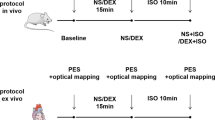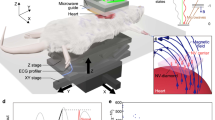Abstract
Aim:
To investigate the potential of propofol in suppressing ventricular arrhythmias and to examine whether mitochondrial ATP-sensitive potassium channels are involved.
Methods:
Male Sprague-Dawley rats were pretreated with intravenous infusion of propofol (Prop), a selective mitochondrial KATP channel inhibitor 5-hydroxydecanoate (5-HD), propofol plus 5-HD (Prop+5-HD), a potent mitochondrial KATP channel opener diazoxide (DZ) or NS, respectively. The dosage of each drug was 10 mg/kg. The animals then underwent a 30 min-ligation of the left anterior descending artery. The severity of arrhythmias, the incidence of ventricular fibrillation (VF), and the time of the first run of ventricular arrhythmias were documented using an arrhythmia scoring system. Mitochondrial membrane potential (ΔΨm) was measured in freshly isolated rat cardiomyocytes with a fluorescence microscope.
Results:
The arrhythmia scores in the Prop and DZ group were 2.6(0-5) and 2.4(0-5), respectively, which were significantly lower than that in the control group [4.9(2-8)]. VF was not observed in both Prop and DZ groups. The first run of ventricular arrhythmias was significantly postponed in the Prop group (10.5±2.2 vs 7.3±1.9 min). Bracketing of propofol with 5-HD eliminated the anti-arrhythmic effect of propofol. In isolated rat cardiomyocytes, propofol (50 μmol/L) significantly decreased ΔΨm, but when propofol was co-administered with 5-HD, the effect on ΔΨm was reversed.
Conclusion:
Propofol preconditioning suppresses ischemia-induced ventricular arrhythmias in the rat heart, which are proposed to be caused by opening of mitochondrial KATP channels.
Similar content being viewed by others
Log in or create a free account to read this content
Gain free access to this article, as well as selected content from this journal and more on nature.com
or
References
Vasileiou I, Xanthos T, Koudouna E, Perrea D, Klonaris C, Katsargyris A, et al. Propofol: a review of its non-anaesthetic effects. Eur J Pharmacol 2009; 605: 1–8.
Liu Q, Kong AL, Chen R, Qian C, Liu SW, Sun BG, et al. Propofol and arrhythmias: two sides of the coin. Acta Pharmacol Sin 2011; 32: 817–23.
Hermann R, Vettermann J . Change of ectopic supraventricular tachycardia to sinus rhythm during administration of propofol. Anesth Analg 1992; 75: 1030–2.
Kannan S, Sherwood N . Termination of supraventricular tachycardia by propofol. Br J Anaesth 2002; 88: 874–5.
Miro O, de la Red G, Fontanals J . Cessation of paroxysmal atrial fibrillation during acute intravenous propofol administration. Anesthesiology 2000; 92: 910.
Burjorjee JE, Milne B . Propofol for electrical storm; a case report of cardioversion and suppression of ventricular tachycardia by propofol. Can J Anaesth 2002; 49: 973–7.
Matejikova J, Kucharska J, Pinterova M, Pancza D, Ravingerova T . Protection against ischemia induced ventricular arrhythmias and myocardial dysfunction conferred by preconditioning in the rat heart: involvement of mitochondrial KATP channels and reactive oxygen species. Physiol Res 2009; 58: 9–19.
Das B, Sarkar C . Is the sarcolemmal or mitochondrial KATP channel activation important in the antiarrhythmic and cardioprotective effects during acute ischemia/reperfusion in the intact anesthetized rabbit model? Life Sci 2005; 77: 1226–48.
Vegh A, Parratt JR . The role of mitochondrial KATP channels in antiarrhythmic effects of ischaemic preconditioning in dogs. Br J Pharmacol 2002; 137: 1107–15.
Das B, Sarkar C, Shankar PR . Pretreatment with sarafotoxin 6c prior to coronary occlusion protects against infarction and arrhythmias via cardiomyocyte mitochondrial KATP channel activation in the intact rabbit heart during ischemia/reperfusion. Cardiovasc Drugs Ther 2007; 21: 243–51.
Alizadeh AM, Faghihi M, Sadeghipour HR, Mohammadghasemi F, Imani A, Houshmand F, et al. Oxytocin protects rat heart against ischemia-reperfusion injury via pathway involving mitochondrial ATP-dependent potassium channel. Peptides 2010; 31: 1341–5.
Hirata N, Kanaya N, Kamada N, Kimura S, Namiki A . Differential effects of propofol and sevoflurane on ischemia induced ventricular arrhythmias and phosphorylated connexin 43 protein in rats. Anesthesiology 2009; 110: 50–7.
Taheri S, Halsey MJ, Liu J, Eger EI 2nd, Koblin DD, Laster MJ . What solvent best represents the site of action of inhaled anesthetics in humans, rats, and dogs? Anesth Analg 1991; 72: 627–34.
Fryer RM, Hsu AK, Nagase H, Gross GJ . Opioid-induced cardioprotection against myocardial infarction and arrhythmias: mitochondrial versus sarcolemmal ATP-sensitive potassium channels. J Pharmacol Exp Ther 2000; 294: 451–7.
Gonca E, Bozdogan O . Both mitochondrial KATP channel opening and sarcolemmal KATP channel blockage confer protection against ischemia/reperfusion-induced arrhythmia in anesthetized male rats. J Cardiovasc Pharmacol Ther 2010; 15: 403–11.
Walker MJ, Curtis MJ, Hearse DJ, Campbell RW, Janse MJ, Yellon DM, et al. The Lambeth Conventions: guidelines for the study of arrhythmias in ischaemia infarction, and reperfusion. Cardiovasc Res 1988; 22: 447–55.
Yang CS, Tsai PJ, Chou ST, Niu YL, Lai JS, Kuo JS . The roles of reactive oxygen species and endogenous opioid peptides in ischemia induced arrhythmia of isolated rat hearts. Free Radic Biol Med 1995; 18: 593–8.
Wickley PJ, Ding X, Murray PA, Damron DS . Propofol-induced activation of protein kinase C isoforms in adult rat ventricular myocytes. Anesthesiology 2006; 104: 970–7.
Murry CE, Jennings RB, Reimer KA . Preconditioning with ischemia: a delay of lethal cell injury in ischemic myocardium. Circulation 1986; 74: 1124–36.
Yamada M . Mitochondrial ATP-sensitive K+ channels, protectors of the heart. J Physiol 2010; 588: 283–6.
Curtis MJ . Characterisation, utilisation and clinical relevance of isolated perfused heart models of ischaemia-induced ventricular fibrillation. Cardiovasc Res 1998; 39: 194–215.
Bernier M, Curtis MJ, Hearse DJ . Ischemia-induced and reperfusion-induced arrhythmias: importance of heart rate. Am J Physiol 1989; 256: H21–31.
Kobayashi I, Kokita N, Namiki A . Propofol attenuates ischaemia-reperfusion injury in the rat heart in vivo. Eur J Anaesthesiol 2008; 25: 144–51.
Garg V, Hu K . Protein kinase C isoform-dependent modulation of ATP-sensitive K+ channels in mitochondrial inner membrane. Am J Physiol Heart Circ Physiol 2007; 293: H322–32.
Wang Y, Hirai K, Ashraf M . Activation of mitochondrial ATP-sensitive K+ channel for cardiac protection against ischemic injury is dependent on protein kinase C activity. Circ Res 1999; 85: 731–41.
Kim MY, Kim MJ, Yoon IS, Ahn JH, Lee SH, Baik EJ, et al. Diazoxide acts more as a PKC-epsilon activator, and indirectly activates the mitochondrial KATP channel conferring cardioprotection against hypoxic injury. Br J Pharmacol 2006; 149: 1059–70.
Sato T, O'Rourke B, Marbán E . Modulation of mitochondrial ATP-dependent K+ channels by protein kinase C. Circ Res 1998; 83: 110–4.
Rahman S, Li J, Bopassa JC, Umar S, Iorga A . Phosphorylation of GSK-3β mediates intralipid-induced cardioprotection against ischemia/reperfusion injury. Anesthesiology 2011; 115: 242–53.
Acknowledgements
We thank Dr Tom XU from Toledo University, USA, for kindly polishing the language of this manuscript. The funding for this study is partly granted by National 973 Project (No 2007CB512008), the National Scientific Fund of China (No 30901392), Shanghai Jiao Tong University School of Medicine Scientific Research Fund, and the Shanghai First People's Hospital Scientific Fund (No 11B24).
Author information
Authors and Affiliations
Corresponding author
Rights and permissions
About this article
Cite this article
Liu, Q., Yao, Jy., Qian, C. et al. Effects of propofol on ischemia-induced ventricular arrhythmias and mitochondrial ATP-sensitive potassium channels. Acta Pharmacol Sin 33, 1495–1501 (2012). https://doi.org/10.1038/aps.2012.86
Received:
Accepted:
Published:
Issue date:
DOI: https://doi.org/10.1038/aps.2012.86
Keywords
This article is cited by
-
Nicorandil Ameliorates Doxorubicin-Induced Cardiotoxicity in Rats, as Evaluated by 7 T Cardiovascular Magnetic Resonance Imaging
Cardiovascular Drugs and Therapy (2023)
-
5-Hydroxydecanoate Abolishes Cardioprotective Effects of a Structural Analogue of Apelin-12 in Ischemia/Reperfusion Injury
International Journal of Peptide Research and Therapeutics (2017)
-
Propofol attenuates H2O2-induced oxidative stress and apoptosis via the mitochondria- and ER-medicated pathways in neonatal rat cardiomyocytes
Apoptosis (2017)



